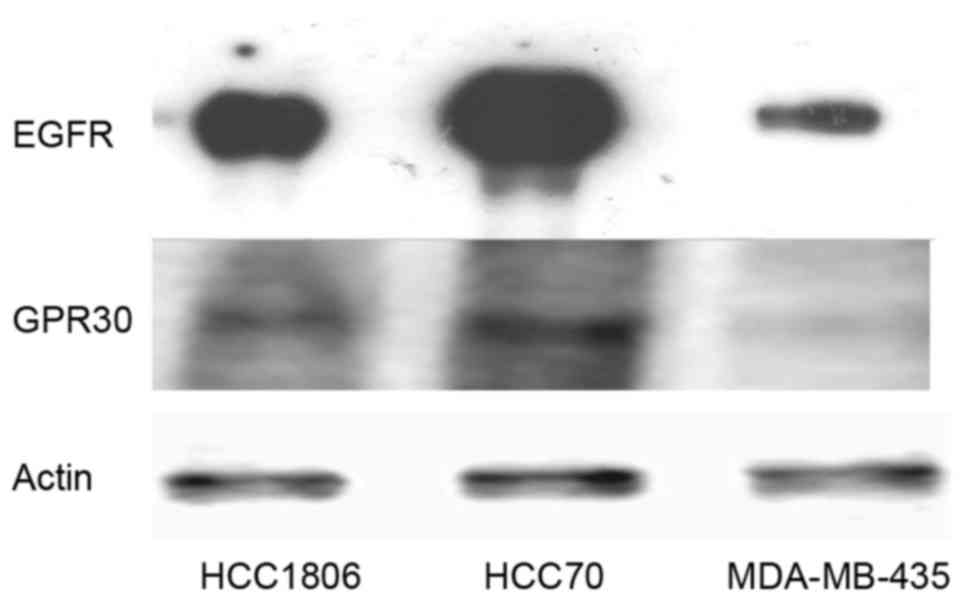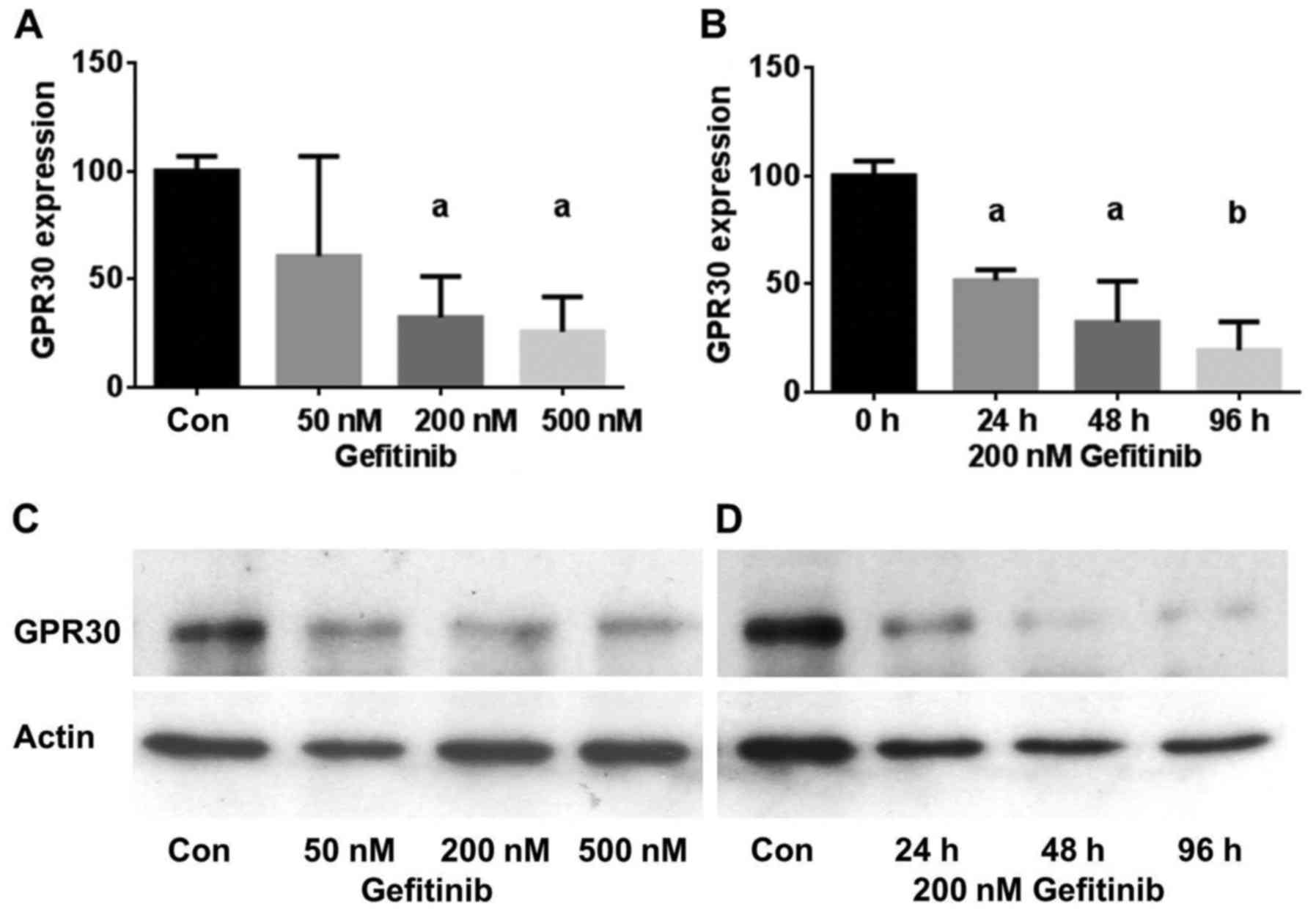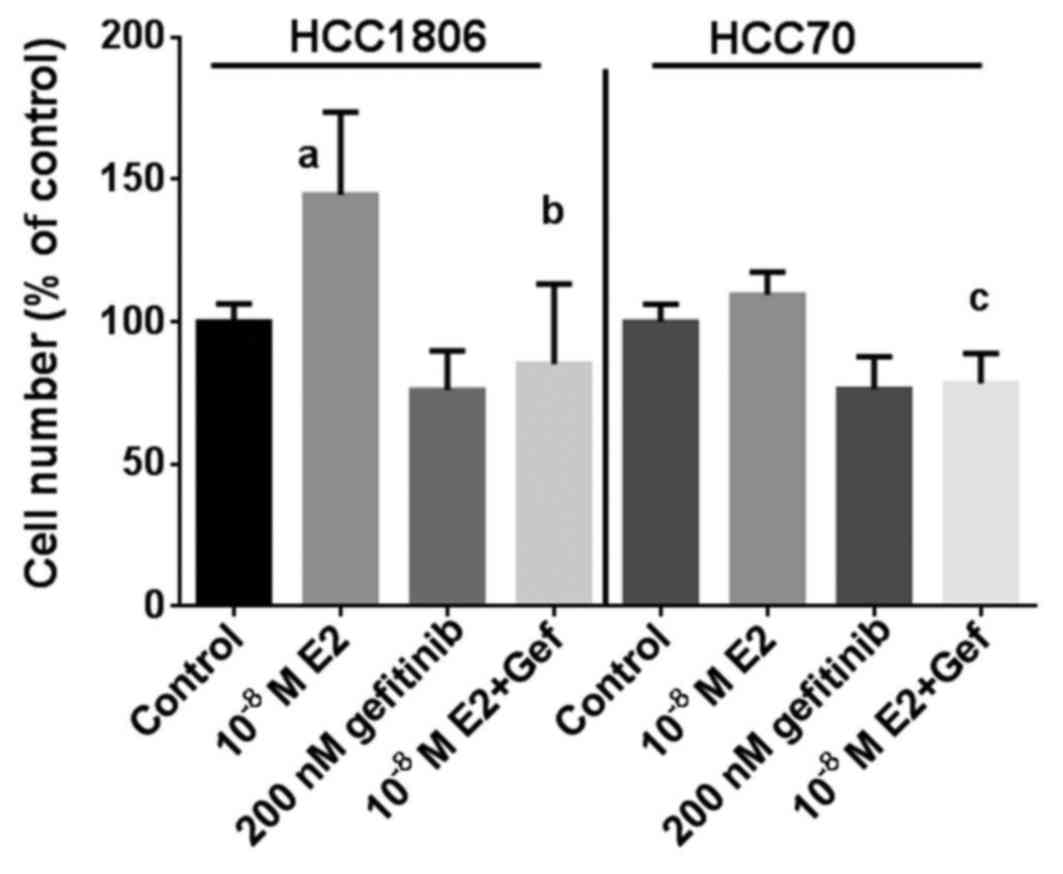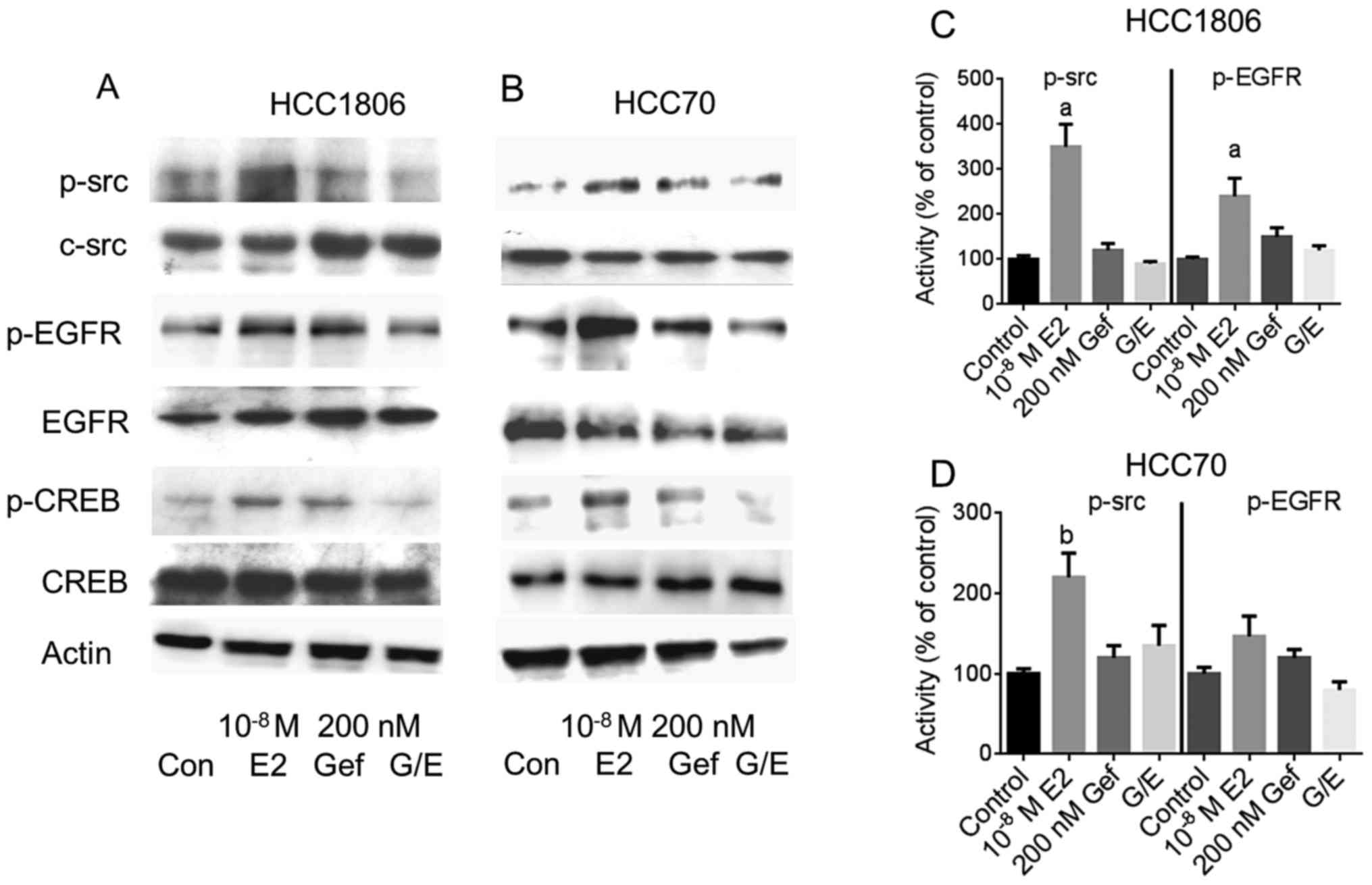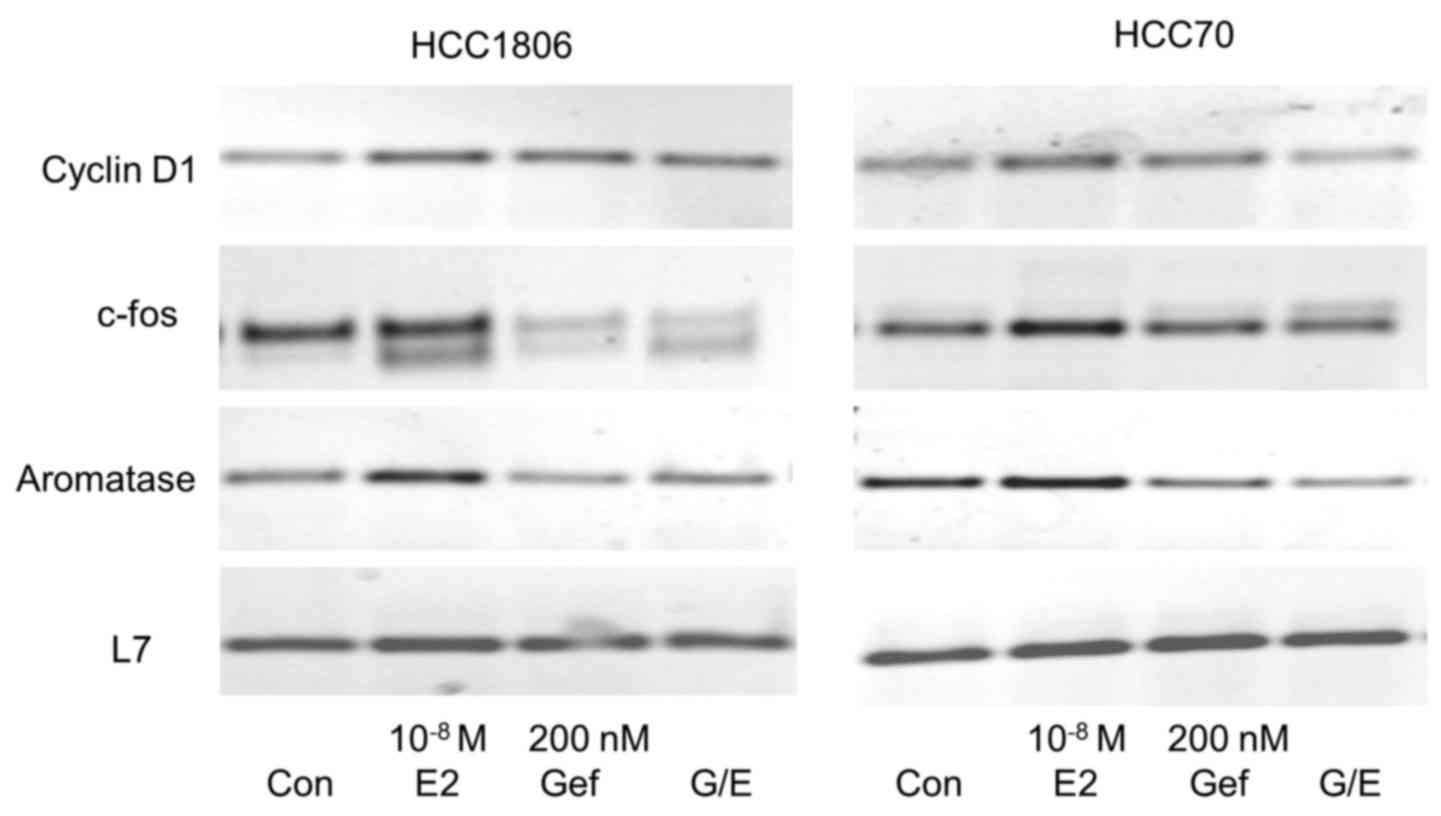17β-estradiol-induced growth of triple-negative breast cancer cells is prevented by the reduction of GPER expression after treatment with gefitinib
- Authors:
- Published online on: December 8, 2016 https://doi.org/10.3892/or.2016.5306
- Pages: 1212-1218
Abstract
Introduction
Triple-negative breast cancer (TNBC) accounts for 10–15% of all breast cancer cases (1). These tumors can currently only be treated by conventional chemotherapy as they lack expression of estrogen receptor α (ERα) and progesterone receptors and cannot be treated with HER2 antibody trastuzumab or other HER2 directed therapies. To date, no successful targeted therapy is available for TNBC patients (2). Consequently, the mortality rate of TNBC patients is still twice as high as for patients having ERα-positive tumors (3). A high proportion (30–52%) of TNBCs overexpress epidermal growth factor receptor (EGFR) and this high expression of EGFR is associated with poor prognosis (4). A number of tyrosine kinase inhibitors (TKIs) preferentially acting on EGFR have been developed in the last decades. Gefitinib (Iressa®) and erlotinib are compounds possessing a high affinity to the hydrophobic ATP-binding pocket of the tyrosine kinase domain of EGFR (5). Gefitinib (ZD1839 or Iressa®) was found to inhibit proliferation of EGFR-overexpressing cancer cell lines by more than 50%, including the TNBC cell line MDA-MB-231 (6).
In a phase II multicenter trial with advanced breast cancer patients, treatment with 500 mg gefitinib per day achieved stable disease for 6 months in 38.7% of patients. Immunohistochemical staining of biopsies of treated patients demonstrated a complete inhibition of EGFR phosphorylation (7). Particularly, breast tumors that developed resistance to tamoxifen benefited from gefitinib treatment showing stable disease for 24 weeks in 54% of patients. In the same study, only 11.5% of ER-negative patients showed stable disease under gefitinib treatment (8).
GPER, also known as GPR30, is a G protein-coupled receptor responsible for nongenomic actions of 17β-estradiol (9,10). Binding of 17β-estradiol to GPER leads to a dissociation of the heterotrimeric G-protein complex. The βγ-subunit activates the tyrosine kinase Src (11). Subsequently, matrix metalloproteases release EGF from the extracellular matrix that initiates autophosphorylation of the EGFR finally leading to the activation of the ras-MAP-kinase pathway (9).
In addition, it has been shown that stimulation of GPER by the synthetic agonist G1 suppressed EMT in the TNBC cell line MDA-MB-231 by downregulation of NF-κB signaling (12). High GPER expression in the breast is one reason for acquired tamoxifen resistance of breast tumors as tamoxifen has been shown to be an agonist of GPER (13).
In TNBC, GPER is also frequently expressed very strongly and high GPER expression in this subgroup of breast cancer was found to correlate with increased recurrence (14). Recently, we provided evidence, that inhibition of the transcription of GPR30 by siRNA is able to prevent 17β-estradiol-dependent growth stimulation of TNBC (15). As siRNA is not applicable in patients, other approaches to lower GPER are necessary. Vivacqua et al reported that in breast cancer cells high expression of GPER correlates with overexpression of the EGFR (16). On the other hand, EGFR is overexpressed in approximately 50% of TNBCs and high EGFR expression is a predictor of a poor prognosis of these breast cancer patients (17).
In the present study, we therefore analyzed the impact of gefitinib on GPER expression and on 17β-estradiol-dependent growth stimulation in TNBC cells.
Materials and methods
Reagents
Gefitinib (Iressa®) was purchased from Selleck Chemicals (Houston, TX, USA). 17β-estradiol (E2), insulin and transferrin were purchased from Sigma-Aldrich (Deisendorf, Germany).
Cell lines
TNBC cell lines HCC70 and HCC1806 both of the basal-like subtype were purchased from the American Type Culture Collection (ATCC; Manassas, VA, USA) and maintained in Dulbecco's modified Eagle's medium (DMEM) (Biochrom GmbH, Berlin, Germany) supplemented with 2 mM glutamine, 6 ng/ml insulin, 10 ng/ml transferrin, penicillin (50 U/ml), streptomycin (50 µg/ml) from Gibco (Paisley, UK) and 10% fetal bovine serum (Biochrom GmbH).
Proliferation assays
Proliferation assays were performed as previously described (18). Charcoal depleted serum (CD-FCS) was prepared according to the procedure described by Stanley et al (19). Cell number was determined by a colorimetric method using Alamar Blue (Biosource, Solingen, Germany).
Proliferation assays were performed at least three times in quadruplicates with different passages. Means and standard deviations of the optical density (OD) of the replicates were calculated.
Treatment of cells
Four million cells of either cell line (HCC70 and HCC1806) were treated for 48 h with 200 nM gefitinib. Twenty-four hours before harvest, the cells were starved from serum. Finally, the cells were stimulated for 15 min with 10−8 M 17β-estradiol. Cells were detached with 1 mM EDTA/PBS and the pellets were lysed in 50 µl CelLytic M containing protease and phosphatase inhibitors (Sigma-Aldrich).
Western blotting
Lysates of cells were cleared and protein was determined using the method of Bradford. Twenty micrograms of each sample were separated in a 7.5% polyacrylamide gel, blotted on a PVDF membrane and detected with rabbit anti-human primary antibodies: anti-GPR30 (sc-48524; Santa Cruz Biotechnology, Inc., Dallas, TX, USA), anti-phospho-Src (2113) and anti-Src (2109) from Cell Signaling Technology, Inc. (Danvers, MA, USA), anti-phospho-Tyr1173 EGFR (324864) from Calbiochem (Darmstadt, Germany), anti-EGFR antibody (2235) supplied by Epitomics (Hamburg, Germany) and anti-actin by Sigma-Aldrich. Blots were washed four times in TBST and further incubated with a 1:20,000 dilution of horseradish peroxidase conjugated goat anti-rabbit antibody (ECL; GE Healthcare, Freiburg, Germany). After washing again for four times, the blots were incubated with chemoluminescence reagent Femto (Thermo Fisher Scientific, Rockford, IL, USA) for 5 min and emitted light was detected on a LI-COR chemoluminescence detector (LI-COR Biosciences, Lincoln, NE, USA). Densitometric evaluation of the protein bands was performed with Image Studio Digits program from LI-COR and expression values of the proteins were normalized to actin.
RT-PCR
RNA of the variously treated TNBC cells was purified using the RNeasy kit (Qiagen, Hilden, Germany). Reverse transcription-polymerase chain reaction of c-fos, cyclin D1 and aromatase was performed as previously described (15).
Agarose gels of PCR products were stained in ethidium bromide (2 µg/ml) for 30 min and photographed on a transiluminator using a CDS camera (Biometra, Göttingen, Germany). The band intensities of the PCR products were evaluated by the Digital Science 1D software (Eastman Kodak, Rochester, NY, USA). Values of the RT-PCR products were normalized to the ribosomal protein L7.
Statistical analysis
The data were tested for significant differences by one-way analysis of variance followed by Student-Newman-Keuls test for comparison of individual groups, after a Bartlett's test had shown that variances were homogenous.
Results
Expression of EGFR and GPER in TNBC cell lines
In order to verify the assumption that expression of GPER parallels the expression of EGFR, 20 µg protein of the TNBC cell lines HCC1806, HCC70 and MDA-MB-435 were analyzed on western blotting for expression of EGFR and GPER (Fig. 1). MDA-MB-435 cells, not amplified for the EGFR gene, contained the lowest amount of EGFR protein. HCC1806 cells expressed 15±3.2-fold the amount of EGFR expressed in the MDA-MB-435 cells. The signal of EGFR was strongest in the HCC70 cells, expressing 48±5.8-fold more EGFR than that noted in the MDA-MB-435 cells.
The analysis of GPER expression in TNBC cell lines confirmed the observation of Vivacqua et al that GPER expression correlates with the amount of EGFR pointing to a direct regulation of GPER by EGF (16). In the cell lines tested, GPER expression was lowest in the MDA-MB-435 cells similar to EGFR and GPER expression was higher in cell lines expressing more EGFR. In the HCC1806 cells, GPER expression was 3.8±0.9-fold the amount detected in the MDA-MB-435 cells and HCC70 cells expressed 8.4±1.4-fold as much GPER as cells of the cell line MDA-MB-435.
Reduction in GPER expression following treatment with gefitinib
To test the hypothesis that inhibition of EGFR reduces expression of GPER, the TNBC cell lines were treated with increasing concentrations of gefitinib for up to 4 days and GPER expression was analyzed by western blotting of the lysates of the treated cells (Fig. 2). A 2-day treatment of HCC1806 cells with 50 nM gefitinib reduced GPER expression to 60.5±46% of the control (NS). Using 200 nM gefitinib, GPER expression was reduced to 32±18% (p<0.05) and 500 nM gefitinib lowered GPER expression in the HCC1806 cells further to 26±16% (p<0.05) (Fig. 2A). The inhibition of GPER expression was also found to be more effective with increasing time of exposure to gefitinib. In the HCC1806 cells treated with 200 nM gefitinib for 24 h, GPER expression decreased to 52±5% (p<0.05) and after 96 h the GPER level reached 39±5% (p<0.01) of the control (Fig. 2B). Fig. 2C shows a representative western blot of the concentration-dependent reduction in GPER expression by gefitinib in the HCC1806 cells. Similar results were obtained with the TNBC cell line HCC70. In Fig. 2D, a representative western blot of the time-dependent decrease in GPER expression after treatment with 200 nM gefitinib for 24–96 h is presented.
Treatment of HCC70 cells with 200 nM gefitinib led to an almost maximal reduction in GPER expression after 24 h to 25±7% (p<0.01) of the control and GPER expression further decreased only slightly after a 96-h treatment with 200 nM gefitinib (15±11%) (p<0.01) (Table I).
Table I.Quantitative evaluation of GPER expression after treatment of TNBC cells with various concentrations of gefitinib for 24 to 96 h. |
Reduction of GPER expression by gefitinib prevents growth stimulation of TNBC by 17β-estradiol
As additional proof that the inhibitory effect of gefitinib on the growth of TNBC depends in part on a reduction in GPER expression, the effect of 17β-estradiol on the proliferation of the TNBC cell lines was analyzed at a concentration of 10−8 M in the absence or in the presence of 200 nM gefitinib (Fig. 3). Within 7 days of culture, the percentage of HCC1806 cells increased to 145±29% (p<0.01) in the presence of 17β-estradiol compared to the controls. Treatment of HCC1806 cells with 200 nM gefitinib alone reduced the percentage of cells to 76±14% of the control. When HCC1806 cells treated with gefitinib were stimulated by 17β-estradiol, the percentage of cells only slightly increase to 85±28% and remained below the control level (Fig. 3, left). The induction of growth of HCC70 cells by 10−8 M 17β-estradiol was less pronounced with an increase of 110±8% of the control; following treatment with 200 nM gefitinib the percentage of HCC70 cells was 76±11% of the control. In the HCC70 cells co-treated with gefitinib stimulation with 17β-estradiol failed to increase the cell percentage after 7 days of culture (78±11%) (Fig. 3, right).
Gefitinib inhibits GPER-dependent phosphorylation of c-src and subsequent activation of EGFR
Next, the impact of the reduction in GPER expression by gefitinib was analyzed on the indirect activation of c-src and EGFR by 10−8 M 17β-estradiol. The two TNBC cell lines, either pretreated with 200 nM gefitinib for 4 days or not, were stimulated with 17β-estradiol and phosphorylation of c-src and EGFR was analyzed by western blotting (Fig. 4A and B).
Even in the serum-starved HCC1806 and HCC70 cells a basal phosphorylation of c-src at Tyr416 was detectable (lane 1). In both cell lines, phosphorylation of c-src was strongly increased after stimulation with 10−8 M 17β-estradiol (Fig. 4A and B, lane 2). Densitometric analysis of the p-src bands revealed that the amount of p-src was increased in the HCC1806 cells to 350±50% of the control (p<0.01) (Fig. 4C) and in HCC70 cells to 220±30% (p<0.05) (Fig. 4D). Pretreatment of the cells for 96 h with 200 nM gefitinib did not change c-src phosphorylation (Fig. 4A and B, lane 3). In both TNBC cell lines pretreatment with 200 nM gefitinib prevented activation of c-src by 10−8 M 17β-estradiol. Whereas in the HCC1806 cells, phosphorylation of c-src by estradiol was diminished by gefitinib from 350 to 90% of the control (Fig. 4C). In the HCC70 cells, activation of c-src was reduced from 220 to 135% of the control, when pretreated for 4 days with 200 nM gefitinib (Fig. 4D).
In the signal transduction of GPER, phosphorylated src activates matrix metalloproteases that release heparin-bound EGF from the extracellular matrix. After binding of EGF to its cognate receptor, EGFR is autophosphorylated at several sites of the cytosolic domain. The increased phosphorylation of the EGFR at Tyr1173 after stimulation of the HCC1806 and HCC70 cells with 10−8 M 17β-estradiol is shown in Fig. 4A and B, lane 2. In HCC1806 cells, Tyr1173 phosphorylation of EGFR increased to 240±40% (p<0.01) of the non-stimulated control (Fig. 4C) and in HCC70 cells to 147±25% (Fig. 4D).
In both cell lines induction of Tyr1173 phosphorylation by 17β-estradiol was almost completely prevented in the cells pretreated with 200 nM gefitinib: pEGFR in HCC1806, 120±10% of the control; in HCC70 cells, 80±10% of the control (Fig. 4C and D).
Pretreatment of TNBC with gefitinib reduces activation of CRE by 17β-estradiol
In addition to the Gβγ-dependent activation of the GPER signaling pathway described above, stimulation of GPER by 17β-estradiol also results in the release of Gα from the heterotrimeric G-protein complex that activates adenylyl cyclase. As a consequence, activity of protein kinase A (PKA) is increased by cAMP leading to the phosphorylation of the cAMP-responsive element binding (CREB) protein.
Phosphorylation of CREB was analyzed by western blotting from cell lysates from the TNBC cell lines (Fig. 4, panels 5 and 6). Stimulation of HCC1806 cells with 10−8 M 17β-estradiol increased phosphorylation of CREB to 144±8% (lane 2) compared to non-stimulated control cells (lane 1). In HCC70 cells, CREB phosphorylation increased to 169±60% of the control due to stimulation with 17β-estradiol. When EGFR was inhibited by 200 nM gefitinib prior to stimulation of HCC1806 and HCC70 cells with 10−8 M 17β-estradiol, activation of CREB was completely prevented: pCREB in HCC1806 cells, 95±21%; HCC70 cells, 82±17% (Fig. 4, lane 4).
Previously, we showed by electrophoretic mobility shift that after stimulation of TNBC cell lines HCC1806 and HCC70 with 17β-estradiol, phospho-CREB binds to the promoter of cyclin D1 (15).
Induction of cyclin D1 expression by 17β-estradiol is inhibited by gefitinib
Cyclin D1 is an important regulator of the transition from G1 to S phase of the cell cycle necessary for the induction of proliferation. Expression of cyclin D1 was analyzed after stimulation of both TNBC cell lines with 10−8 M 17β-estradiol for 30 min (Fig. 5, first panel).
In HCC1806 cells we observed a distinct expression of cyclin D1 mRNA in the serum-starved control cells. This high basal cyclin D1 expression increased to 125±16% after a 30-min stimulation with 10−8 M 17β-estradiol (lane 2). In HCC1806 cells pretreated for 96 h with 200 nM gefitinib, cyclin D1 expression was lower than in the control cells (lane 3). In the gefintinib-treated HCC1806 cells stimulation with 17β-estradiol was not able to increase cyclin D1 expression (96±12%).
In the non-stimulated HCC70 cells, cyclin D1 was more strongly expressed than in the HCC1806 cells. A 30-min stimulation of these cells with 10−8 M 17β-estradiol elevated the cyclin D1 mRNA content to 129±13% of the control (Fig. 5, lane 2). Pretreatment of HCC70 cells with 200 nM gefitinib completely prevented induction of cyclin D1 expression by 17β-estradiol (82±12%) (Fig. 5, lane 4).
Gefitinib prevents induction of c-fos expression by 17β-estradiol
Following activation of EGFR, the growth promoting signal is forwarded via MAP kinase Erk to the nucleus where subsequent expression of c-fos is induced. Serum-starved cells of the two different TNBC cell lines (HCC1806 and HCC70) were stimulated for 30 min with 10−8 M 17β-estradiol. mRNA of these cells was analyzed for c-fos expression by RT-PCR and compared to the expression in non-stimulated cells. Stimulation of HCC1806 cells with 17β-estradiol increased c-fos expression to 155±35% (p<0.05) of the control (Fig. 5, second panel, lane 2). In the HCC70 cells, induction of c-fos by estradiol was less pronounced reaching only 140±10% compared to the serum-starved control. In HCC1806 cells, wherein expression of GPER was reduced after treatment with 200 nM gefitinib for 96 h, c-fos expression was 45% lower than that in the control cells (Fig. 5, lane 3) and induction of c-fos expression by 17β-estradiol was completely prevented (48±9%) (Fig. 5, lane 4). In HCC70 cells pretreated with gefitinib a slight increase in c-fos expression was still observed but only by the factor 1.1±0.2.
Aromatase expression in TNBC cells
Aromatase (CYP19A1) is an enzyme of the cytochrome 450 family catalyzing the formation of the non-saturated A-ring of estradiol. The promoter of the aromatase gene contains a cAMP-responsive element (20). For this reason we expected that aromatase is regulated by GPER. Stimulation of TNBC cell line HCC1806 cells with 17β-estradiol led to an increase in mRNA for aromatase to 128±25% (Fig. 5, third panel, lane 2). The reduction in GPER expression by pretreatment of HCC1806 cells with 200 nM gefitinib for 96 h prevented the induction of aromatase expression by 17β-estradiol completely (96±5%) (Fig. 5, lane 4). In HCC70 cells 17β-estradiol increased aromatase expression to 137±10% but in cells pretreated with gefitinib mRNA of aromatase was less abundant than that in the control cells (65±18%).
Discussion
Patients with TNBC have very poor prognosis due to the lack of expression of ERα, progesterone receptor and HER2-amplification in their tumors. EGFR is overexpressed in about 50% of TNBC and high EGFR expression predicts the poor prognosis of these breast cancer patients (17).
Although TNBC cells per definition do not express the nuclear estrogen receptor ERα, we observed a growth stimulation of 45% in the TNBC cell line HCC1806 by 17β-estradiol (Fig. 3). This enhanced growth is caused by GPER, the estrogen receptor responsible for the non-genomic effects of 17β-estradiol. Previously, we showed that knockdown of GPER using specific siRNA prevented this growth stimulation by 17β-estradiol in TNBC cell lines (15). In search of more physiological ways to downregulate GPER expression, we found in the literature the indication that GPER expression parallels the expression of EGFR (16). In TNBC, strong expression of GPER is also prevalent in addition to overexpression of EGFR and strong GPER expression in this cohort was associated with young age and poor outcome (14).
There are small molecular compounds, such as gefitinib or erlotinib, binding to the kinase domain of the EGFR and successfully inhibiting phosphorylation of the cytosolic domain of EGFR and downregulating EGFR signaling (5).
Here, we proved the interrelation between GPER expression and EGFR activity, as inhibition of EGFR using gefitinib dramatically reduced GPER expression for example by up to 85% in the HCC70 cells after 96 h (Table I).
In fact, this downregulation of GPER expression by gefitinib reduced the induction of cell growth of HCC1806 and HCC70 cells by 10−8 M 17β-estradiol below the level of non-stimulated cells (85±28 and 76±11%, respectively).
Clinical trials treating an unselected population of breast cancer patients with gefitinib as a single agent were not successful. Nonetheless, immunohistochemical analysis of biopsies of treated tumors revealed complete inhibition of EGFR phosphorylation (7). In a further study, the treatment of 58 heavily pretreated patients with metastatic breast cancer using 500 mg gefitinib per day resulted in partial tumor response in one patient (21).
In one clinical trial particularly targeting EGFR in TNBC patients with gefitinib, stable disease for 24 weeks was achieved at least in two of 25 patients (22). There are probably alternative mechanisms of pathway activation circumventing EGFR activation (23).
In a phase II trial of 181 women with ER-negative breast cancer, pathologic complete response (pCR) to gefitinib was achieved in 17% of TNBC patients, whereas in only 2% of non-TNBC patients pCR was observed after gefitinib treatment for 12 weeks (24).
In the present study, we investigated a new strategy to target GPER in TNBC. We used 200 nM gefitinib (Iressa®) as a selective reversible inhibitor of EGFR tyrosine kinase to downregulate GPER expression. Clinical trials for breast cancer have been performed with a daily dosage of 500 mg gefitinib resulting in an estimated serum concentration of approximately 100 µM (7).
In order to confirm the specificity of the downregulation of GPER expression by gefitinib, we analyzed the downstream signaling of GPER after downregulation of its expression by gefitinib. As described by Filardo et al the tyrosine kinase Src is activated by the βγ-subunit of heterotrimeric G-proteins after binding of 17β-estradiol to GPER and EGF released from the extracellular matrix by matrix metalloproteases induces autophosphorylation of the EGFR (9).
As shown in Fig. 4, downregulation of GPER expression completely prevented activation of the non-receptor tyrosine kinase c-src and of EGFR activation by 17β-estradiol. Attempts to pharmacologically inhibit GPER in TNBC cell lines using estriol or the GPER-specific inhibitor G15 also proved promising but the concentrations of these inhibitors necessary to achieve a sufficient reduction of 17β-estradiol-induced cell proliferation were not achievable in vivo (25). This fact rules out an application of these compounds in clinical trials.
In this study, we showed that the proportion of growth of TNBC cells that was induced by 17β-estradiol was successfully inhibited by gefitinib via reduction of GPER expression. The use of gefitinib may be a therapeutic option particularly in TNBCs expressing high amounts of GPER. We expect from our results that in TNBC patients selected for high expression of GPER, gefitinib will prove to be more effective than in an unselected population of breast cancer patients.
Acknowledgements
We thank Sonja Blume for the excellent technical assistance. This study was supported by grant GR 1895/10-1 of the German Research Foundation.
References
|
Petrelli F, Cabiddu M, Ghilardi M and Barni S: Current data of targeted therapies for the treatment of triple-negative advanced breast cancer: Empiricism or evidence-based? Expert Opin Investig Drugs. 18:1467–1477. 2009. View Article : Google Scholar : PubMed/NCBI | |
|
Podo F, Buydens LM, Degani H, Hilhorst R, Klipp E, Gribbestad IS, Van Huffel S, van Laarhoven HW, Luts J, Monleon D, et al: FEMME Consortium: Triple-negative breast cancer: Present challenges and new perspectives. Mol Oncol. 4:209–229. 2010. View Article : Google Scholar : PubMed/NCBI | |
|
Carey LA, Dees EC, Sawyer L, Gatti L, Moore DT, Collichio F, Ollila DW, Sartor CI, Graham ML and Perou CM: The triple negative paradox: Primary tumor chemosensitivity of breast cancer subtypes. Clin Cancer Res. 13:2329–2334. 2007. View Article : Google Scholar : PubMed/NCBI | |
|
Reis-Filho JS and Tutt AN: Triple negative tumours: A critical review. Histopathology. 52:108–118. 2008. View Article : Google Scholar : PubMed/NCBI | |
|
Wakeling AE, Guy SP, Woodburn JR, Ashton SE, Curry BJ, Barker AJ and Gibson KH: ZD1839 (Iressa): An orally active inhibitor of epidermal growth factor signaling with potential for cancer therapy. Cancer Res. 62:5749–5754. 2002.PubMed/NCBI | |
|
Anderson NG, Ahmad T, Chan K, Dobson R and Bundred NJ: ZD1839 (Iressa), a novel epidermal growth factor receptor (EGFR) tyrosine kinase inhibitor, potently inhibits the growth of EGFR-positive cancer cell lines with or without erbB2 overexpression. Int J Cancer. 94:774–782. 2001. View Article : Google Scholar : PubMed/NCBI | |
|
Baselga J, Albanell J, Ruiz A, Lluch A, Gascón P, Guillém V, González S, Sauleda S, Marimón I, Tabernero JM, et al: Phase II and tumor pharmacodynamic study of gefitinib in patients with advanced breast cancer. J Clin Oncol. 23:5323–5333. 2005. View Article : Google Scholar : PubMed/NCBI | |
|
Gutteridge E, Agrawal A, Nicholson R, Cheung K Leung, Robertson J and Gee J: The effects of gefitinib in tamoxifen-resistant and hormone-insensitive breast cancer: A phase II study. Int J Cancer. 126:1806–1816. 2010.PubMed/NCBI | |
|
Filardo EJ, Quinn JA, Frackelton AR Jr and Bland KI: Estrogen action via the G protein-coupled receptor, GPR30: Stimulation of adenylyl cyclase and cAMP-mediated attenuation of the epidermal growth factor receptor-to-MAPK signaling axis. Mol Endocrinol. 16:70–84. 2002. View Article : Google Scholar : PubMed/NCBI | |
|
Haynes MP, Li L, Sinha D, Russell KS, Hisamoto K, Baron R, Collinge M, Sessa WC and Bender JR: Src kinase mediates phosphatidylinositol 3-kinase/Akt-dependent rapid endothelial nitric-oxide synthase activation by estrogen. J Biol Chem. 278:2118–2123. 2003. View Article : Google Scholar : PubMed/NCBI | |
|
Luttrell LM, Daaka Y and Lefkowitz RJ: Regulation of tyrosine kinase cascades by G-protein-coupled receptors. Curr Opin Cell Biol. 11:177–183. 1999. View Article : Google Scholar : PubMed/NCBI | |
|
Chen ZJ, Wei W, Jiang GM, Liu H, Wei WD, Yang X, Wu YM, Liu H, Wong CK, Du J, et al: Activation of GPER suppresses epithelial mesenchymal transition of triple negative breast cancer cells via NF-κB signals. Mol Oncol. 10:775–788. 2016. View Article : Google Scholar : PubMed/NCBI | |
|
Ignatov A, Ignatov T, Weissenborn C, Eggemann H, Bischoff J, Semczuk A, Roessner A, Costa SD and Kalinski T: G-protein-coupled estrogen receptor GPR30 and tamoxifen resistance in breast cancer. Breast Cancer Res Treat. 128:457–466. 2011. View Article : Google Scholar : PubMed/NCBI | |
|
Steiman J, Peralta EA, Louis S and Kamel O: Biology of the estrogen receptor, GPR30, in triple negative breast cancer. Am J Surg. 206:698–703. 2013. View Article : Google Scholar : PubMed/NCBI | |
|
Girgert R, Emons G and Gründker C: Inactivation of GPR30 reduces growth of triple-negative breast cancer cells: Possible application in targeted therapy. Breast Cancer Res Treat. 134:199–205. 2012. View Article : Google Scholar : PubMed/NCBI | |
|
Vivacqua A, Lappano R, De Marco P, Sisci D, Aquila S, De Amicis F, Fuqua SA, Andò S and Maggiolini M: G protein-coupled receptor 30 expression is up-regulated by EGF and TGF alpha in estrogen receptor alpha-positive cancer cells. Mol Endocrinol. 23:1815–1826. 2009. View Article : Google Scholar : PubMed/NCBI | |
|
Nielsen TO, Hsu FD, Jensen K, Cheang M, Karaca G, Hu Z, Hernandez-Boussard T, Livasy C, Cowan D, Dressler L, et al: Immunohistochemical and clinical characterization of the basal-like subtype of invasive breast carcinoma. Clin Cancer Res. 10:5367–5374. 2004. View Article : Google Scholar : PubMed/NCBI | |
|
Girgert R, Bartsch C, Hill SM, Kreienberg R and Hanf V: Tracking the elusive antiestrogenic effect of melatonin: A new methodological approach. Neuro Endocrinol Lett. 24:440–444. 2003.PubMed/NCBI | |
|
Stanley ER, Palmer RE and Sohn U: Development of methods for the quantitative in vitro analysis of androgen-dependent and autonomous Shionogi carcinoma 115 cells. Cell. 10:35–44. 1977. View Article : Google Scholar : PubMed/NCBI | |
|
Chen S, Zhou D, Yang C, Okubo T, Kinoshita Y, Yu B, Kao YC and Itoh T: Modulation of aromatase expression in human breast tissue. J Steroid Biochem Mol Biol. 79:35–40. 2001. View Article : Google Scholar : PubMed/NCBI | |
|
von Minckwitz G, Jonat W, Fasching P, du Bois A, Kleeberg U, Lück HJ, Kettner E, Hilfrich J, Eiermann W, Torode J, et al: A multicentre phase II study on gefitinib in taxane- and anthracycline-pretreated metastatic breast cancer. Breast Cancer Res Treat. 89:165–172. 2005. View Article : Google Scholar : PubMed/NCBI | |
|
Green MD, Francis PA, Gebski V, Harvey V, Karapetis C, Chan A, Snyder R, Fong A, Basser R and Forbes JF: Australian New Zealand Breast Cancer Trials Group: Gefitinib treatment in hormone-resistant and hormone receptor-negative advanced breast cancer. Ann Oncol. 20:1813–1817. 2009. View Article : Google Scholar : PubMed/NCBI | |
|
Carey LA, Rugo HS, Marcom PK, Mayer EL, Esteva FJ, Ma CX, Liu MC, Storniolo AM, Rimawi MF, Forero-Torres A, et al: TBCRC 001: Randomized phase II study of cetuximab in combination with carboplatin in stage IV triple-negative breast cancer. J Clin Oncol. 30:2615–2623. 2012. View Article : Google Scholar : PubMed/NCBI | |
|
Bernsdorf M, Ingvar C, Jörgensen L, Tuxen MK, Jakobsen EH, Saetersdal A, Kimper-Karl ML, Kroman N, Balslev E and Ejlertsen B: Effect of adding gefitinib to neoadjuvant chemotherapy in estrogen receptor negative early breast cancer in a randomized phase II trial. Breast Cancer Res Treat. 126:463–470. 2011. View Article : Google Scholar : PubMed/NCBI | |
|
Girgert R, Emons G and Gründker C: Inhibition of GPR30 by estriol prevents growth stimulation of triple-negative breast cancer cells by 17β-estradiol. BMC Cancer. 14:9352014. View Article : Google Scholar : PubMed/NCBI |



